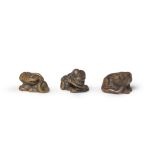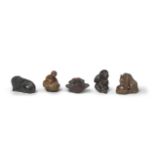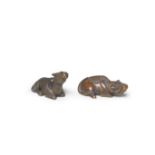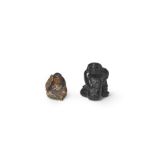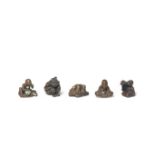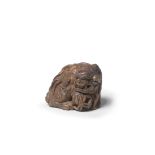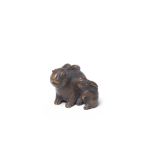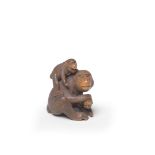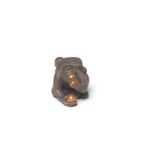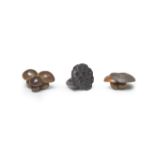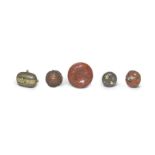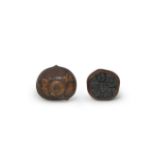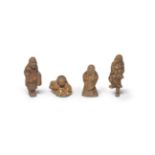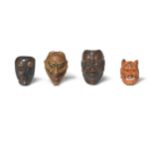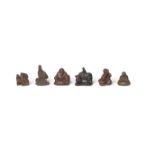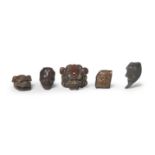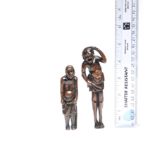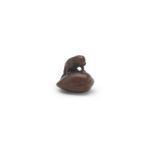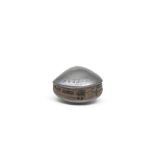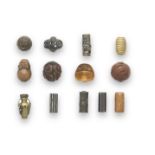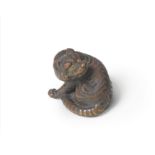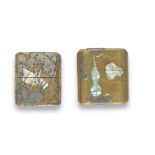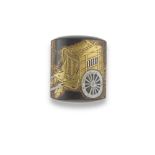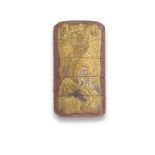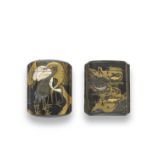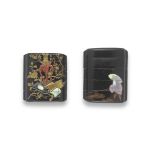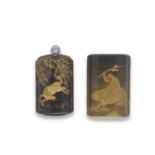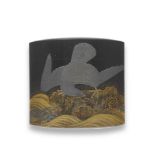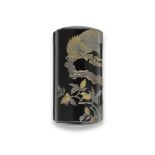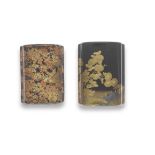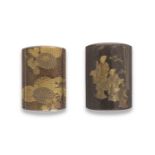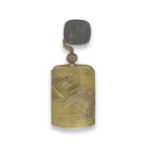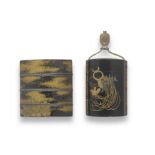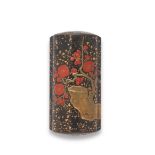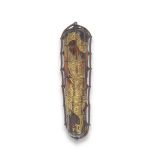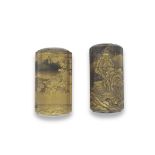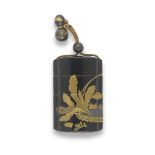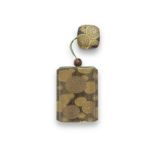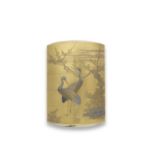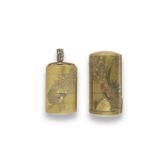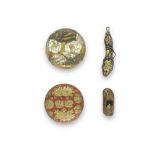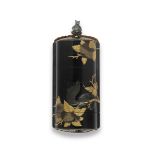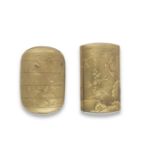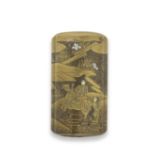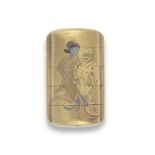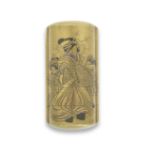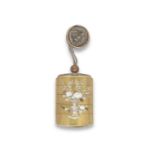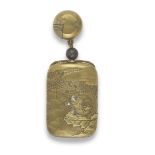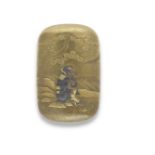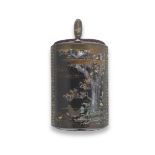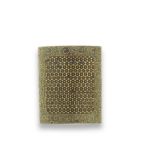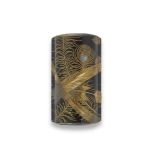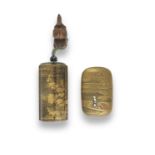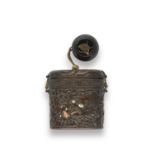Refine your search
Filtered by:
- Category
- List
- Grid
A subscription to the Price Guide is required to view results for auctions ten days or older. Click here for more information
THREE WOOD TIGER NETSUKEEdo period (1615-1868) to Meiji era (1868-1912), 19th centuryThe first a tiger turning back with its long tail trailing up...
FIVE WOOD ANIMAL NETSUKEEdo period (1615-1868) to Meiji era (1868-1912), 19th centuryAll unsigned unless otherwise stated; the first a recumbent d...
TWO WOOD NETSUKE OF RECUMBENT OXEN Edo period (1615-1868) to Meiji era (1868-1912), 19th century (2)
TWO WOOD NETSUKE OF RECUMBENT OXENEdo period (1615-1868) to Meiji era (1868-1912), 19th centuryThe first seated with its head raised, the eyes inl...
TWO WOOD FIGURE NETSUKEEdo period (1615-1868), 18th to 19th centuryThe first ebony, Daikoku hauling a bale of rice, the handle of his hammer inlai...
FIVE WOOD FIGURE NETSUKE Edo period (1615-1868) to Meiji era (1868-1912), 19th to early 20th cent...
FIVE WOOD FIGURE NETSUKEEdo period (1615-1868) to Meiji era (1868-1912), 19th to early 20th centuryThe first a man seated on a large square fan, s...
A WOOD NETSUKE OF TWO SHISHI By Sato Masayoshi (1819-1865), Edo period (1615-1868), mid-19th century
A WOOD NETSUKE OF TWO SHISHIBy Sato Masayoshi (1819-1865), Edo period (1615-1868), mid-19th century The adult shown seated looking to the right, w...
A WOOD NETSUKE OF TWO RABBITS By Masanao, Yamada, Ise Province, Edo period (1615-1868), 19th cen...
A WOOD NETSUKE OF TWO RABBITSBy Masanao, Yamada, Ise Province, Edo period (1615-1868), 19th centuryThe adult seated with her long ears pressed com...
A WOOD NETSUKE OF TWO MONKEYSBy Sadakazu, Edo period (1615-1868), 19th centuryThe adult monkey seated and holding a peach with both hands tantalis...
A WOOD NETSUKE OF TWO MONKEYS By Masanao, Yamada, Ise Province, Edo period (1615-1868), 19th century
A WOOD NETSUKE OF TWO MONKEYSBy Masanao, Yamada, Ise Province, Edo period (1615-1868), 19th centuryThe adult monkey seated cross legged, leaning f...
A WOOD NETSUKE OF A MONKEY By Masanao, Yamada, Ise Province, Edo period (1615-1868), 19th century
A WOOD NETSUKE OF A MONKEYBy Masanao, Yamada, Ise Province, Edo period (1615-1868), 19th centuryThe monkey seated in a leisurely manner, one hand ...
THREE WOOD NETSUKEEdo period (1615-1868) to Meiji era (1868-1912), 19th centuryThe first a cluster of three round capped mushrooms, signed Minko w...
FIVE WOOD NETSUKEEdo period (1615-1868) to Meiji era (1868-1912), 19th centuryAll unsigned unless otherwise stated; the first a dried shiitake mus...
A GROUP OF SEVEN NETSUKE, A WALNUT CARVING, AND A MINIATURE SAYA (SHEATH) INRO Edo period (1615-1...
A GROUP OF SEVEN NETSUKE, A WALNUT CARVING, AND A MINIATURE SAYA (SHEATH) INROEdo period (1615-1868) to Meiji era (1868-1912), 19th centuryAll uns...
TWO WOOD NETSUKEEdo period (1615-1868) to Meiji era (1868-1912), 19th centuryThe first a large chestnut with a flowering chrysanthemum, unsigned, ...
FOUR WOOD FIGURE NETSUKEEdo period (1615-1868) to Meiji era (1868-1912), 19th centuryThe first an oni (demon) soliciting funds for a temple, holdi...
FOUR MASK NETSUKEEdo period (1615-1868) to Meiji era (1868-1912), 19th centuryThree of wood, one of lacquered wood; the first wood, an Okina (Old ...
SIX WOOD FIGURE NETSUKEEdo period (1615-1868) to Meiji era (1868-1912), 19th centuryThe first a crouched Sanbaso dancer, the mask inlaid, signed M...
FIVE ASSORTED MASK NETSUKE Edo period (1615-1868) to Meiji era (1868-1912), 18th to 19th century (5)
FIVE ASSORTED MASK NETSUKEEdo period (1615-1868) to Meiji era (1868-1912), 18th to 19th centuryAll unsigned unless otherwise stated; the first woo...
TWO TALL WOOD NETSUKEEdo period (1615-1868), late 18th to mid-19th centuryThe first a long-legged South Sea Islander standing, one hand held above...
A WOOD NETSUKE OF A KAPPA By Suketada, Takayama, Hida Province, Edo period (1615-1868), mid-19th ...
A WOOD NETSUKE OF A KAPPABy Suketada, Takayama, Hida Province, Edo period (1615-1868), mid-19th centuryThe kappa standing on a large clam, attempt...
A LACQUERED-WOOD NETSUKE OF THE 'CLAM'S DREAM' Edo period (1615-1868) or Meiji era (1868-1912), 1...
A LACQUERED-WOOD NETSUKE OF THE 'CLAM'S DREAM'Edo period (1615-1868) or Meiji era (1868-1912), 19th centuryThe clam lacquered silver with bands of...
THREE WOOD NETSUKEEdo period (1615-1868), 19th centuryThe first the Chinese hero Yojo (Chinese: Yu Rang) seated, stabbing the robe of his rival Ch...
A GROUP OF 53 ASSORTED OJIME (FASTENERS) Edo period (1615-1868) to Meiji era (1868-1912), mid-19t...
A GROUP OF 53 ASSORTED OJIME (FASTENERS)Edo period (1615-1868) to Meiji era (1868-1912), mid-19th to early 20th centuryComprising ojime of various...
A WOOD NETSUKE OF A TIGER By Naito Toyomasa (1773-1856), Tanba Province, early/mid-19th century (2)
A WOOD NETSUKE OF A TIGERBy Naito Toyomasa (1773-1856), Tanba Province, early/mid-19th centuryThe sabre-toothed tiger seated, turning left to look...
TWO INLAID GOLD-LACQUER INRORinpa Style Edo period (1615-1868), 17th/18th centuryThe first with an upright broad body of four cases, the kinji gro...
TSUCHIDA SOETSUA Black-Lacquer Small Three-Case Inro Edo period (1615-1868), 18th centuryThe roiro ground decorated in gold takamaki-e and mura-na...
AN INLAID GOLD AND CARVED-RED-LACQUER FOUR-CASE INRO Edo period (1615-1868), late 18th/early 19th...
AN INLAID GOLD AND CARVED-RED-LACQUER FOUR-CASE INROEdo period (1615-1868), late 18th/early 19th centuryOf upright form, decorated in gold takamak...
TWO INLAID BLACK-LACQUER FOUR-CASE INROEdo period (1615-1868), 18th centuryEach of upright form, the first decorated in gold takamaki-e and hirama...
TWO BLACK-LACQUER SMALL FOUR-CASE INROEdo period (1615-1868), 19th centuryThe first lacquered on the upright roiro (black-lacquer) body in gold an...
TWO BLACK-LACQUER INROEdo period (1615-1868), 19th centuryThe first of upright form with four cases decorated with a continuous design of a monkey...
KOMA YASUTADAA Black-Lacquer Three-Case Inro Edo period (1615-1868), 19th centuryThe broad, flattened rich roiro (black-lacquer) ground decorated ...
KOMA KORYU LINEAGE A Black-Lacquer Five-Case Inro Edo period (1615-1868), probably 19th century
KOMA KORYU LINEAGEA Black-Lacquer Five-Case Inro Edo period (1615-1868), probably 19th centuryThe vertical rectangular body with a lustrous roiro ...
TWO LACQUER FOUR-CASE INROEdo period (1615-1868), probably 18th centuryThe first decorated in gold lacquer and red takamaki-e with a swarm of cica...
TWO LACQUER FOUR-CASE INROOne by Yoshiaki, Edo period (1615-1868), 19th centuryEach of upright form and decorated in different shades of gold taka...
SUNRYUSAI KYOCHIKA (DATES UNKNOWN) AND SHIBATA ZESHIN (1807-1891) A Gold-Lacquer Four-Case Inro E...
SUNRYUSAI KYOCHIKA (DATES UNKNOWN) AND SHIBATA ZESHIN (1807-1891)A Gold-Lacquer Four-Case Inro Edo period (1615-1868), 19th century A Lacquer Hako...
TWO BLACK-LACQUER THREE-CASE INROEdo period (1615-1868), probably 19th centuryThe first of slender small upright form decorated on the roiro groun...
A BLACK-LACQUER FIVE-CASE INROEdo period (18615-1868), 19th centuryThe upright sparsely sprinkled Gyobu nashiji black-lacquered ground decorated i...
A LACQUERED-WOOD ELONGATED SLENDER RIBBED FIVE-CASE INRO Edo period (1615-1868), 19th century
A LACQUERED-WOOD ELONGATED SLENDER RIBBED FIVE-CASE INROEdo period (1615-1868), 19th century The mottled orange-tan lacquered body decorated in go...
KAJIKAWA LINEAGETwo Black-Lacquer Five-Case Inro Edo period (1615-1868), 19th century Each of upright form and similarly lacquered in gold takamak...
KAJIKAWA LINEAGEA Black-Lacquer Small Three-Case Inro Edo period (1615-1868), 19th centuryThe upright body decorated in gold and silver takamaki-e...
A GOLD-LACQUER FOUR-CASE INROEdo period (1615-1868), 19th centuryThe top and bottom of upright form, the broad body decorated in gold takamaki-e w...
HASEGAWA SHIGEYOSHI LINEAGE A Gold-Lacquer Four-Case Inro Edo period (1615-1868) or Meiji era (18...
HASEGAWA SHIGEYOSHI LINEAGEA Gold-Lacquer Four-Case Inro Edo period (1615-1868) or Meiji era (1868-1912), mid/late 19th century The kinji upright,...
TWO GOLD-LACQUER INRO One by Josen(sai) and one by Hasensai, Edo period (1615-1868), 19th century...
TWO GOLD-LACQUER INROOne by Josen(sai) and one by Hasensai, Edo period (1615-1868), 19th centuryThe first decorated in gold takamaki-e with a peac...
ONE GOLD-LACQUERED THREE-CASE INRO AND ONE INLAID WOOD THREE-CASE INRO Edo period (1615-1868) or ...
ONE GOLD-LACQUERED THREE-CASE INRO AND ONE INLAID WOOD THREE-CASE INROEdo period (1615-1868) or Meiji era (1868-1912), mid/late 19th centuryThe fi...
A RED-LACQUER CIRCULAR TWO-CASE INRO, AN INLAID GOLD-LACQUER CIRCULAR KOBAKO (SMALL BOX), AND TWO...
A RED-LACQUER CIRCULAR TWO-CASE INRO, AN INLAID GOLD-LACQUER CIRCULAR KOBAKO (SMALL BOX), AND TWO NETSUKEEdo period (1615-1868) to Meiji era (1868...
HARA YOYUSAI (1772-1845/6) A Black-Lacquer Five-Case Inro Edo period (1615-1868), 19th century
HARA YOYUSAI (1772-1845/6)A Black-Lacquer Five-Case Inro Edo period (1615-1868), 19th century Decorated in black, gold takamaki-e, kirikane, and i...
HARA YOYUSAI (1772-1845/6) A Gold-and-Polychrome-Lacquered Small Four-Case Inro Edo period (1615-...
HARA YOYUSAI (1772-1845/6)A Gold-and-Polychrome-Lacquered Small Four-Case Inro Edo period (1615-1868), 19th centuryDecorated in gold and polychrom...
TWO GOLD-LACQUER FOUR-CASE INROOne by Kakosai, Edo period (1615-1868), 19th centuryThe first of upright form, the kinji ground decorated in gold t...
KAKOSAI SHOZAN LINEAGE An Inlaid Gold-Lacquer Four-Case Inro Edo period (1615-1868), early/mid-19...
KAKOSAI SHOZAN LINEAGEAn Inlaid Gold-Lacquer Four-Case Inro Edo period (1615-1868), early/mid-19th centuryDecorated in gold takamaki-e, e-nashiji ...
RYOSHOSAI KOJIA Gold-Lacquer Four-Case Inro Edo period (1615-1868), 19th centuryThe upright form with kinji ground decorated in gold and silver ta...
KAKYOSAI SHOZANA Gold-Lacquer Five-Case Inro Edo period (1615-1868), 19th centuryThe upright form with kinji ground decorated in gold and slight-c...
SHIBAYAMA STYLE A Shibayama-Inlaid Gold-Lacquer Four-Case Inro Meiji era (1868-1912), late 19th/e...
SHIBAYAMA STYLEA Shibayama-Inlaid Gold-Lacquer Four-Case Inro Meiji era (1868-1912), late 19th/early 20th centuryThe upright kinji body decorated ...
SHIBAYAMA STYLE A Gold-Lacquer Small Three-Case Inro Meiji era (1868-1912), late 19th/early 20th ...
SHIBAYAMA STYLEA Gold-Lacquer Small Three-Case Inro Meiji era (1868-1912), late 19th/early 20th centuryThe kinji upright broad body decorated in g...
SHOKASAI AND SHIBAYAMA LINEAGE An Inlaid and Gold-Lacquer Four-Case Inro Meiji era (1868-1912), l...
SHOKASAI AND SHIBAYAMA LINEAGEAn Inlaid and Gold-Lacquer Four-Case Inro Meiji era (1868-1912), late 19th/early 20th century The lenticular kinji g...
SHOKASAI (ACTIVE 19TH CENTURY) An Inlaid Gold-Lacquer Four-Case Inro Edo period (1615-1868) or Me...
SHOKASAI (ACTIVE 19TH CENTURY)An Inlaid Gold-Lacquer Four-Case Inro Edo period (1615-1868) or Meiji era (1868-1912), early/mid-19th centuryThe len...
ANONYMOUS, SOMADA LINEAGE A Black-Lacquer and Shell-Inlaid Four-Case Inro Edo period (1615-1868),...
ANONYMOUS, SOMADA LINEAGEA Black-Lacquer and Shell-Inlaid Four-Case Inro Edo period (1615-1868), 19th centuryThe black-lacquer ground inlaid in sh...
SOMADA LINEAGEAn Inlaid Lacquer Four-Case Inro Edo period (1615-1868), 19th century The flattened broad roiro body decorated in typical Somada-sty...
A BLACK-LACQUER FOUR-CASE INROEdo period (1615-1868), 19th centuryDecorated in gold and silver takamaki-e and hiramaki-e with a continuous design ...
TWO GOLD-LACQUER INRO One by Shokasai, Edo period (1615-1868) or Meiji era (1868-1912), late 19th...
TWO GOLD-LACQUER INROOne by Shokasai, Edo period (1615-1868) or Meiji era (1868-1912), late 19th/early 20th centuryThe first of upright form with ...
A CARVED WOOD TONKOTSU (TOBACCO POUCH)Edo period (1615-1868), probably 19th centuryThe body carved in varying degrees of relief with a continuous ...

